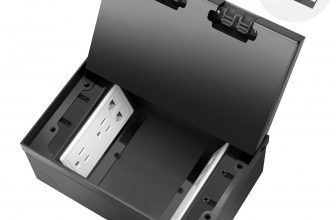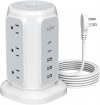In this article, we’ll delve into the Apalie Silicone Vacuum Tubing, exploring its unique features, installation process, and overall utility. Designed for high-temperature environments, this silicone hose is perfect for various applications in engines, making it an essential component for car enthusiasts and mechanics alike.
Product Features
| Feature | Specification |
|---|---|
| Product Name | Apalie Silicone Vacuum Tubing Hose |
| Available Sizes | 4mm, 6mm, 8mm, 12mm Inner Diameter |
| Wall Thickness | 3mm |
| Outer Diameter | 10mm, 12mm, 14mm, 18mm |
| Length | 5ft |
| Temperature Range | -60°C to 200°C (-76°F to 392°F) |
| Material | High-temperature-resistant silicone |
| Uses | Air and liquid transportation, lubricating oil transfer |
| Installation Steps | Select size, remove old pipe, install new hose |
Product Overview
| Pros |
|---|
| High-temperature resistance for durability |
| Flexible and easy to install |
| Comprehensive size options for different needs |
| Cons |
|---|
| Not suitable for transmission oil hoses |
| Requires selecting the right size for optimal use |
Understanding High-Temperature Silicone Tubing
Understanding high-temperature silicone tubing is crucial for many industries, particularly in automotive applications. When it comes to an automotive engine, the environment can be harsh. High-temperature silicone tubing, like that from Apalie, means having a flexible yet durable material that can withstand the heat and pressure generated during operation. Silicone’s unique chemical composition allows it to maintain its integrity and flexibility even under extreme conditions, enhancing overall performance.
Temperature resistance is key; many standard rubber materials can break down or lose functionality when exposed to elevated temperatures, leading to potential failures or inefficiencies. In contrast, high-temperature silicone maintains its properties, ensuring that critical functions in the engine—such as vacuum lines and cooling systems—continue operating smoothly.
Apalie offers various options in terms of inner and outer diameter measurements, which can be tailored to specific applications. It’s essential to select the correct diameter to ensure optimal performance; a hose that is too big may lead to leaks and pressure loss, while one that is too small can restrict flow. By choosing a size that fits perfectly, you’re not just ensuring reliability; you’re enhancing the overall efficiency of the system. So, when making decisions regarding your automotive applications, consider the immense benefits that Apalie’s high-temperature silicone vacuum hose can provide.
Installation and Practical Applications of Silicone Vacuum Hose
Installing the Apalie Silicone Vacuum Tubing is a straightforward process, but I’ve found that paying attention to detail is key to ensuring optimal performance. Start by measuring the area where the tubing will be installed to determine the correct length and diameter. Using the right size is crucial, as an ill-fitting hose can lead to leaks or reduced performance.
Once you have the right measurements, gather your tools – you’ll need a sharp knife for cutting the tubing, clamps for securing it, and possibly a heat gun if you’re working in tighter spaces. First, cut the tubing to the desired length, making a clean, straight cut to prevent any jagged edges. I always recommend checking that the cut ends are free from burrs or roughness to ensure a snug fit.
Next, slide the tubing over the fittings or pipes until it covers the entire connection. It’s essential to avoid stretching the tubing excessively, as this can compromise its integrity and lead to failures later. Once positioned, secure the hose with clamps, tightening them evenly to avoid over-compression, which can damage the silicone.
Common mistakes include using hoses that are too long or short, leading to installation challenges. Also, failing to secure the tubing properly can cause it to pull away from the connection, leading to vacuum leaks.
In terms of practical applications, the Apalie hose shines in automotive repair and maintenance. Think about using it for vacuum lines, coolant systems, or even exhaust setups. Its high-temperature resistance makes it suitable for near-engine components that experience intense heat. By selecting the proper size for your application, you ensure an effective seal and optimal performance. Whether you’re a DIY enthusiast or a seasoned mechanic, choosing the right silicone vacuum hose can make all the difference in your project’s success.
Conclusions
In summary, the Apalie Silicone Vacuum Tubing is an excellent choice for those requiring a reliable and high-performing vacuum hose for engines. With its high-temperature resistance and easy installation process, it stands out in the automotive market. However, be mindful of its limitations when selecting the right product for your specific needs.










